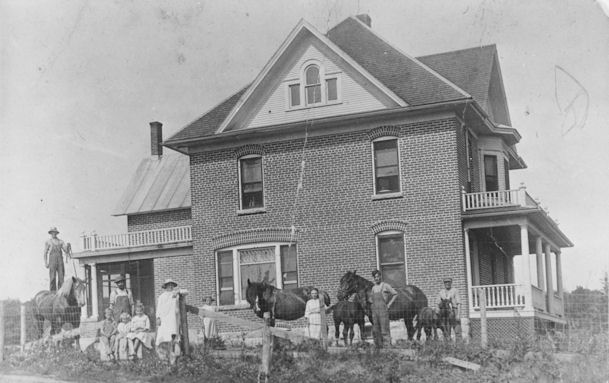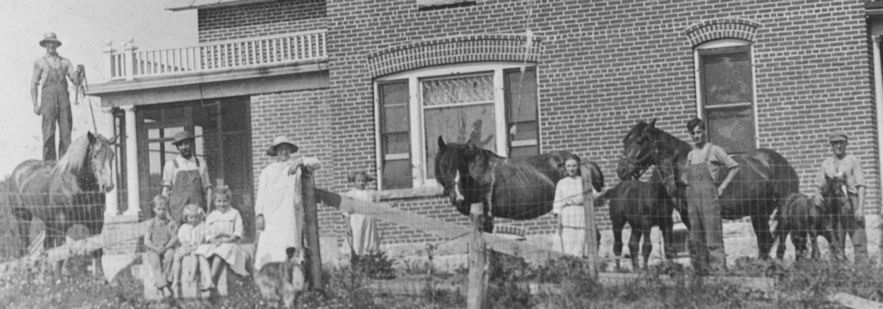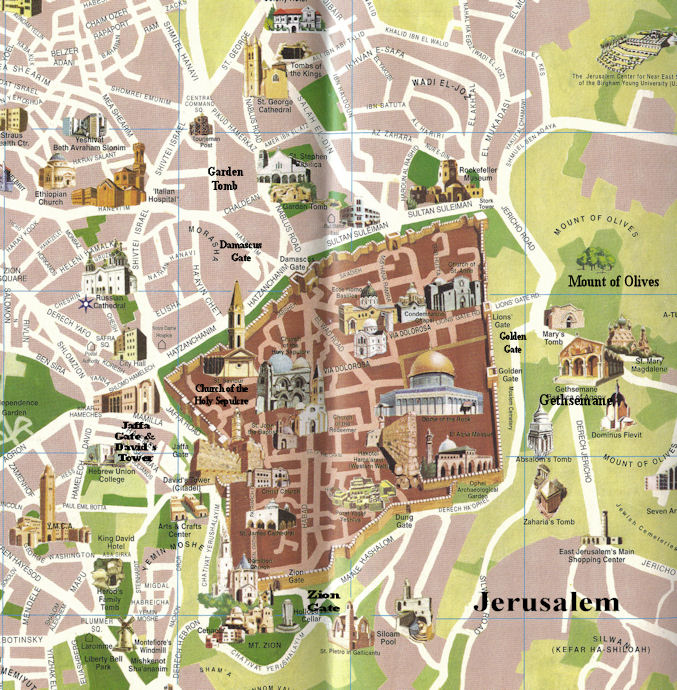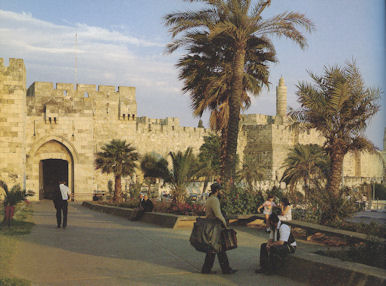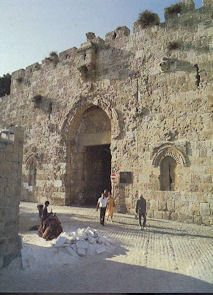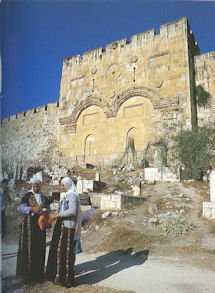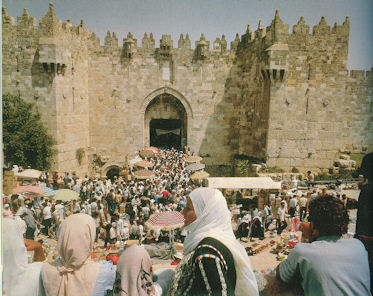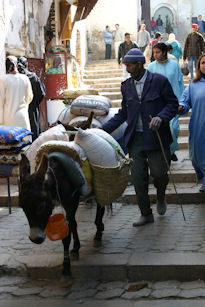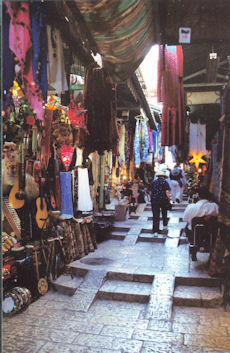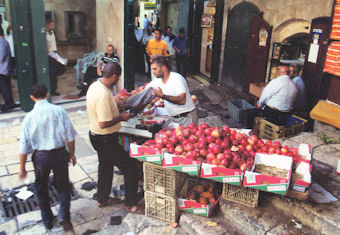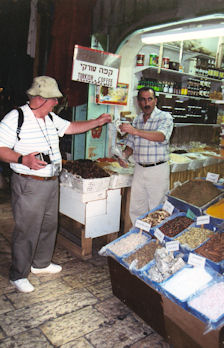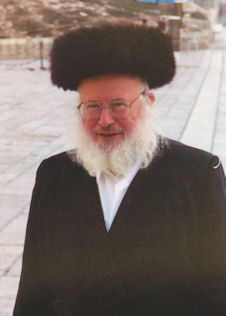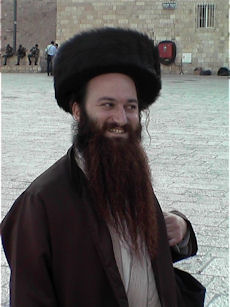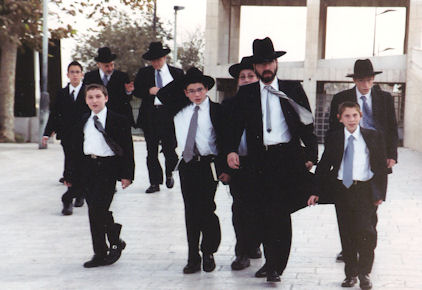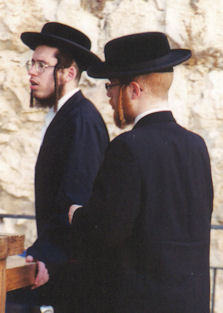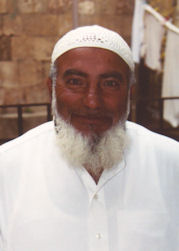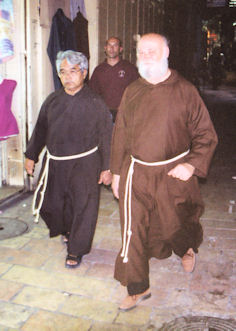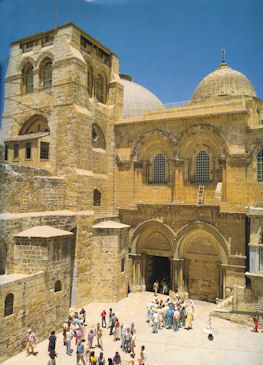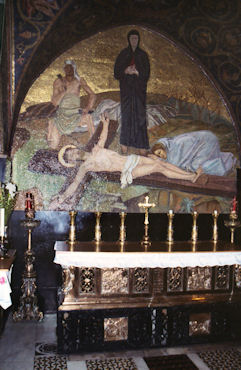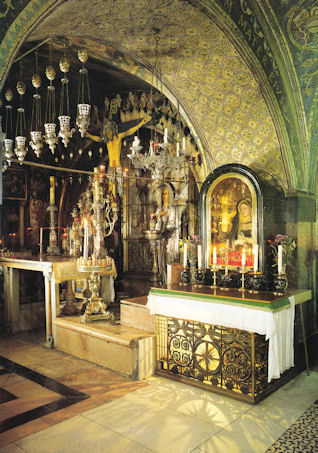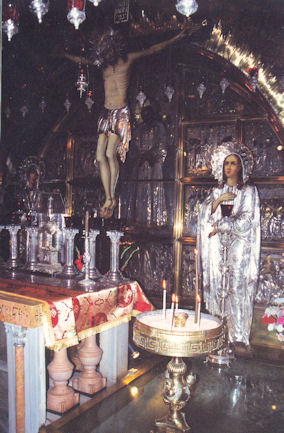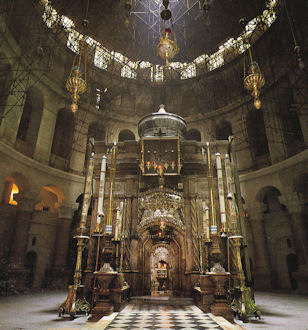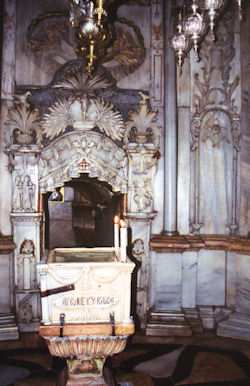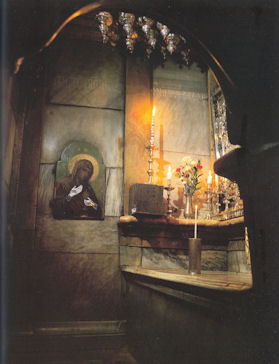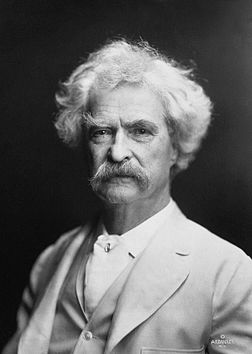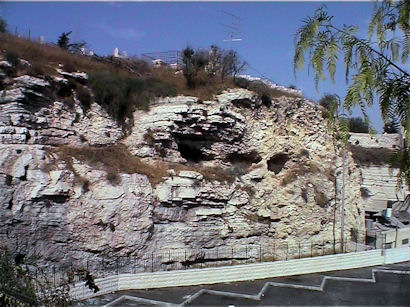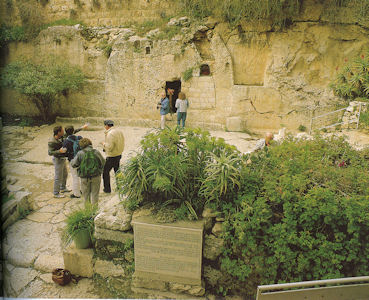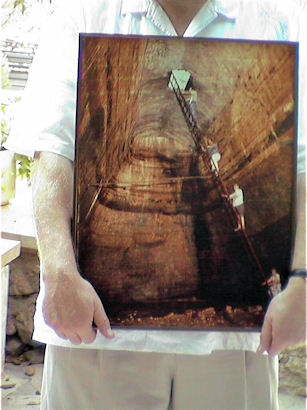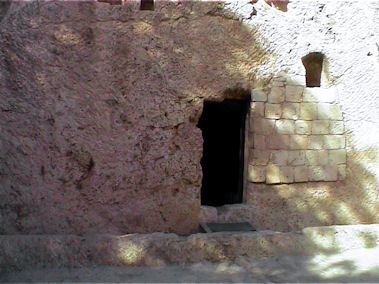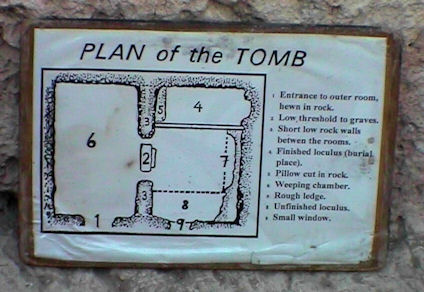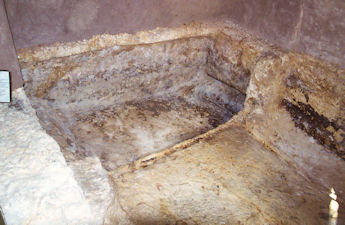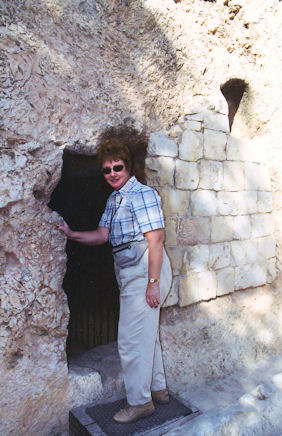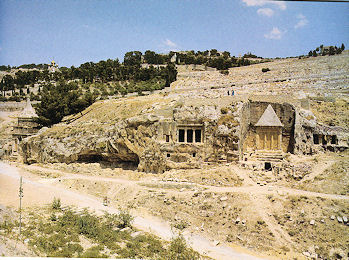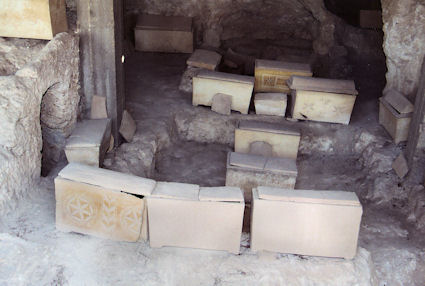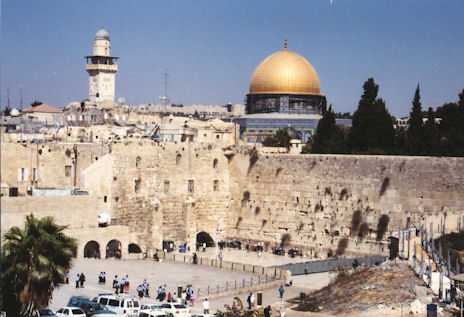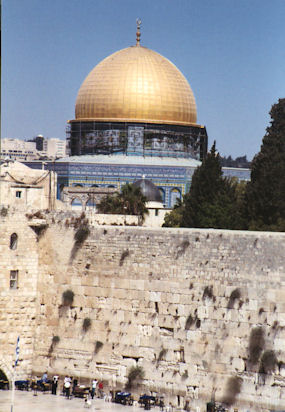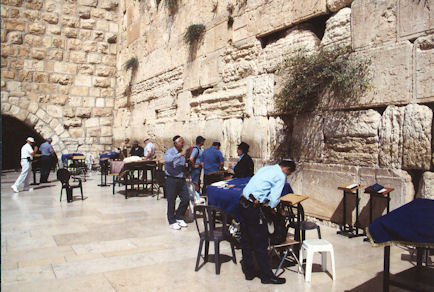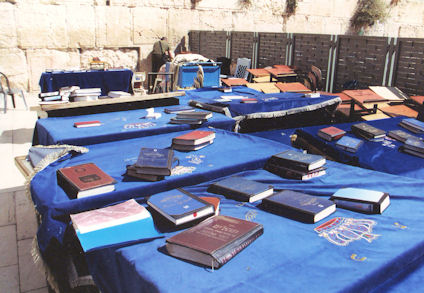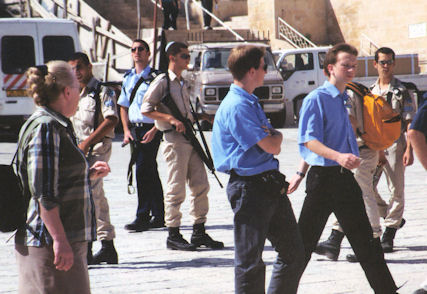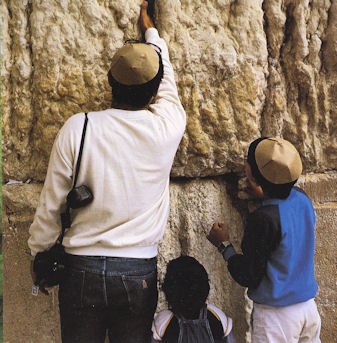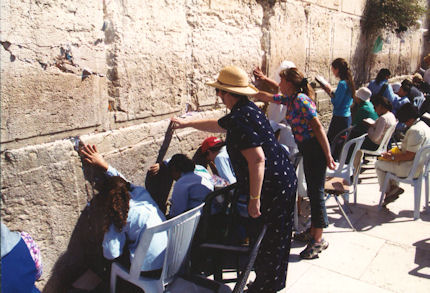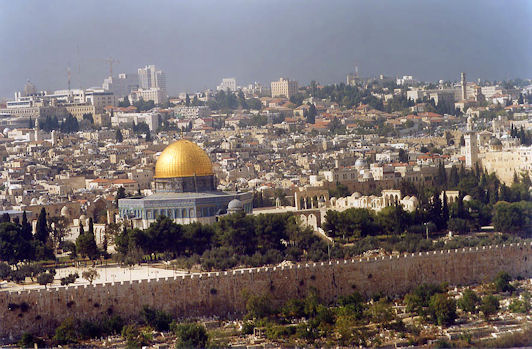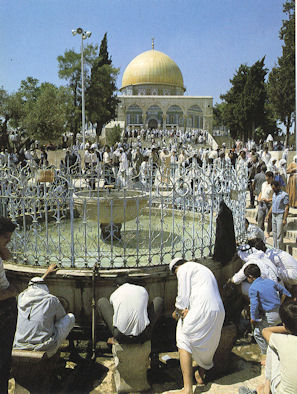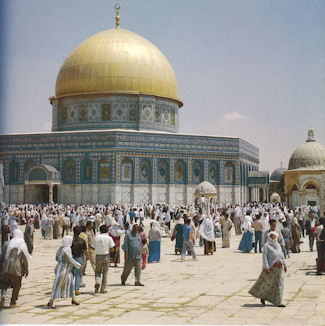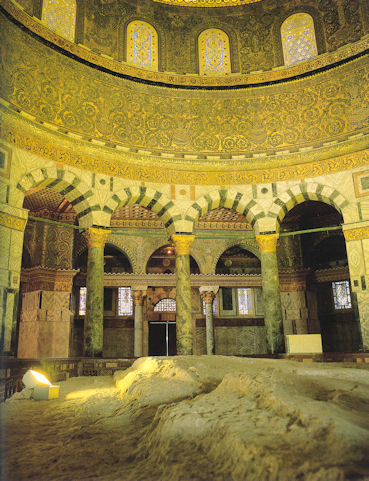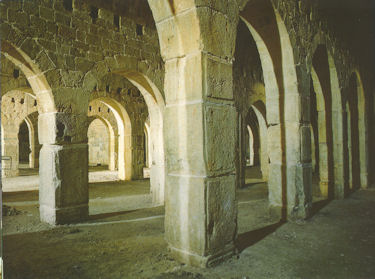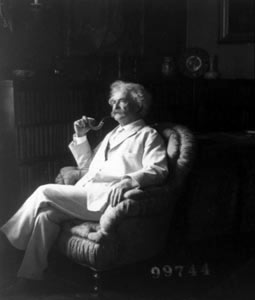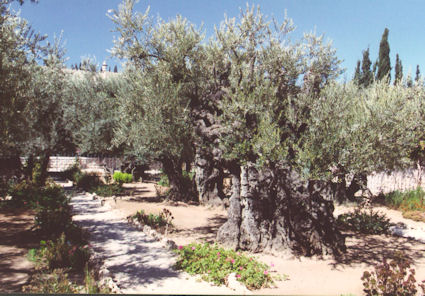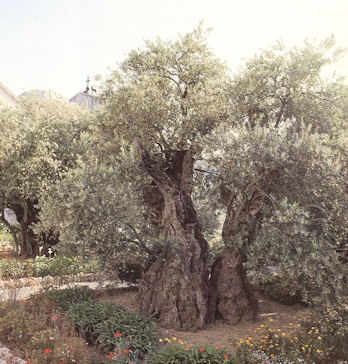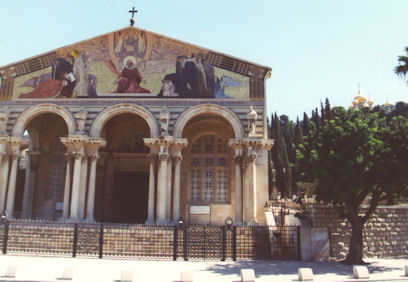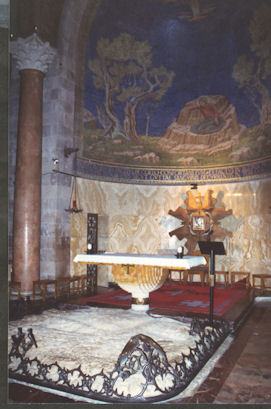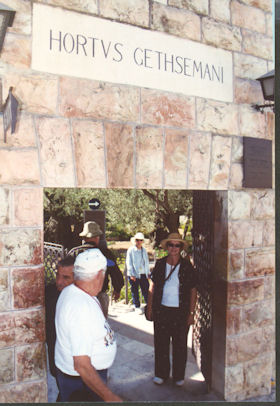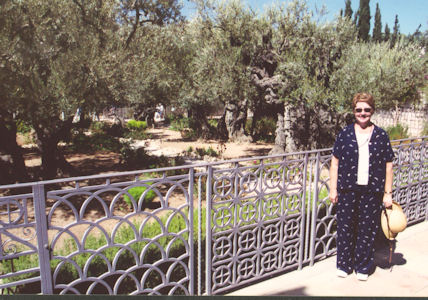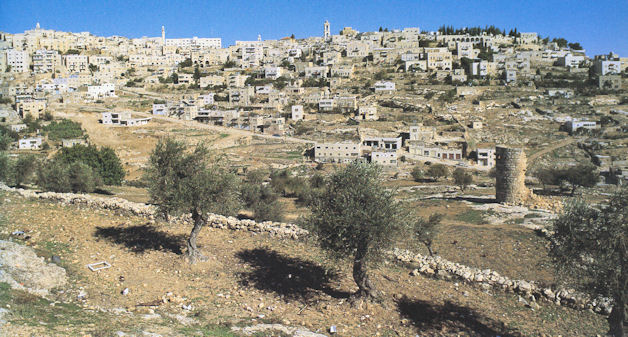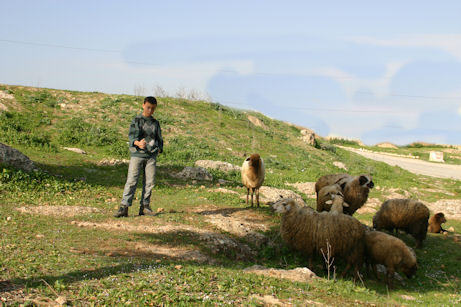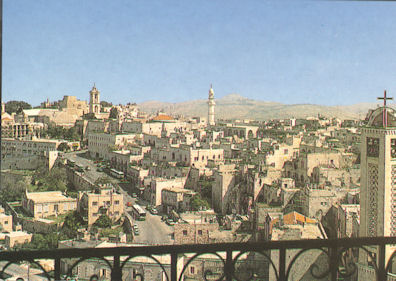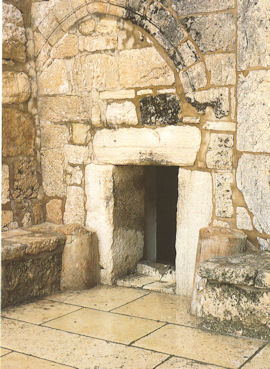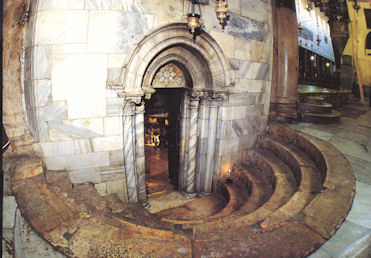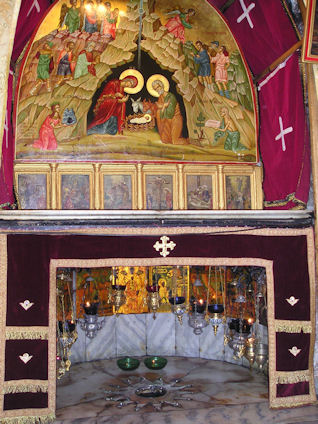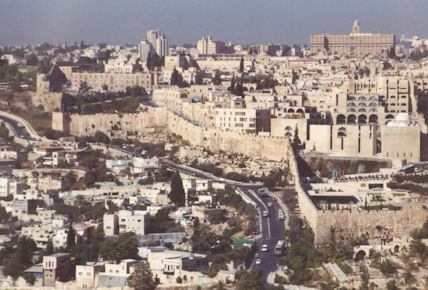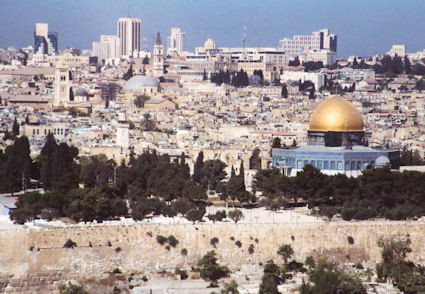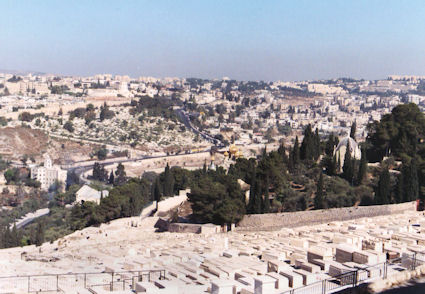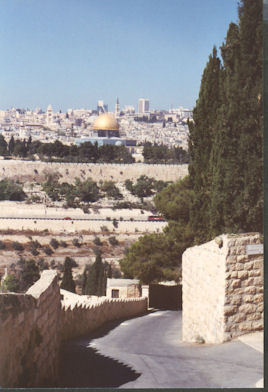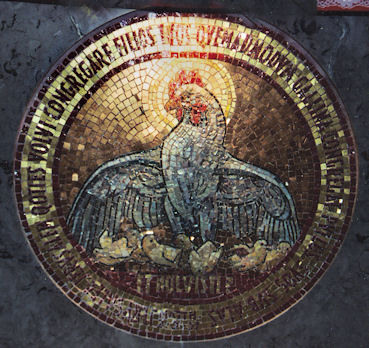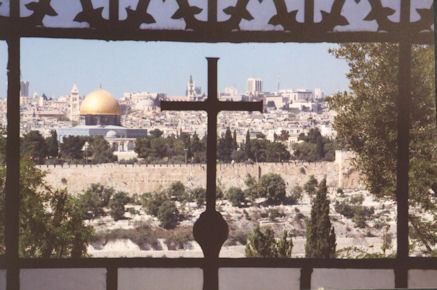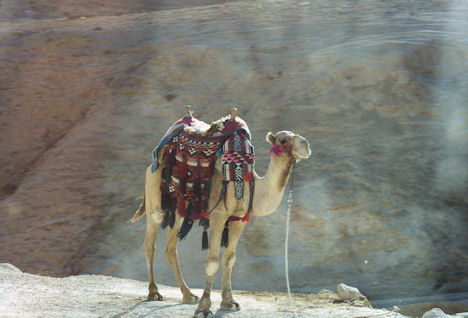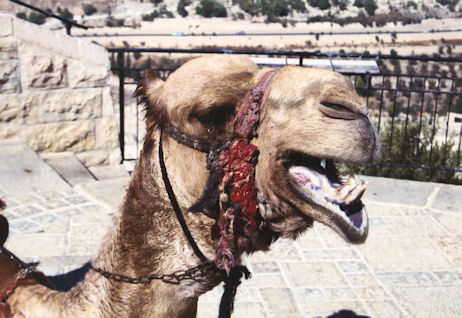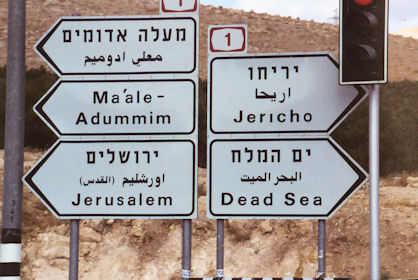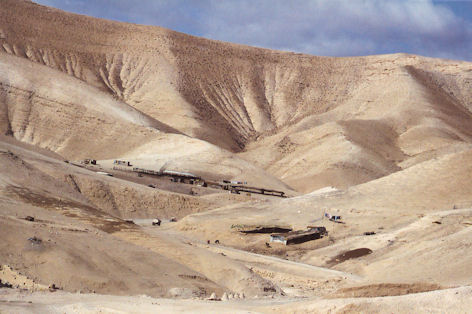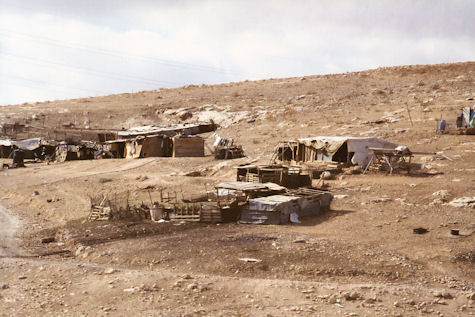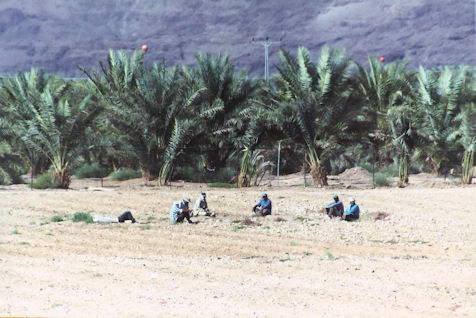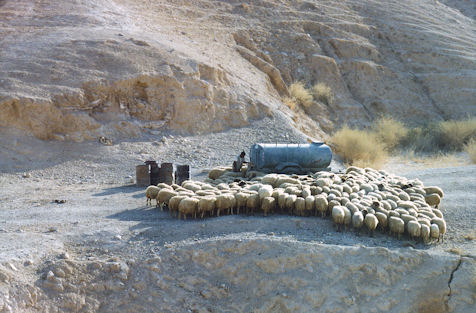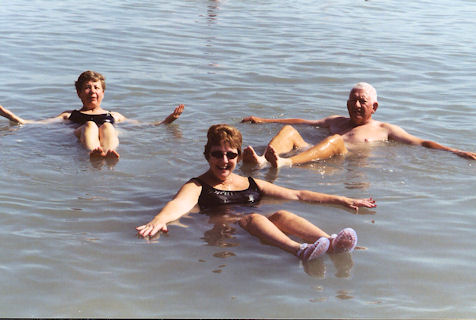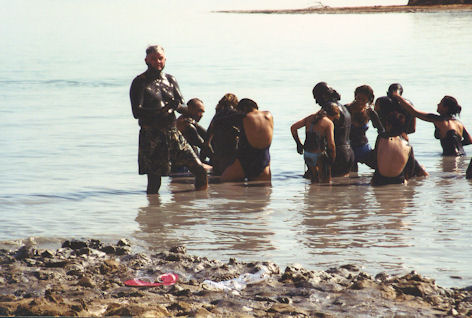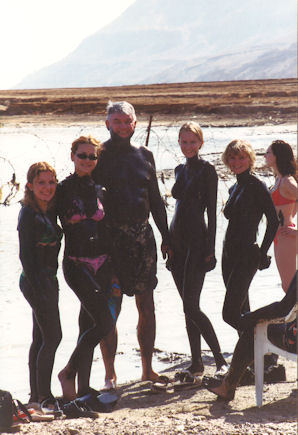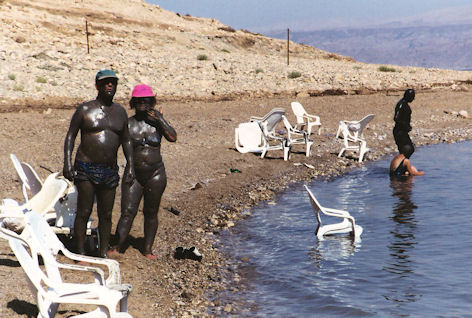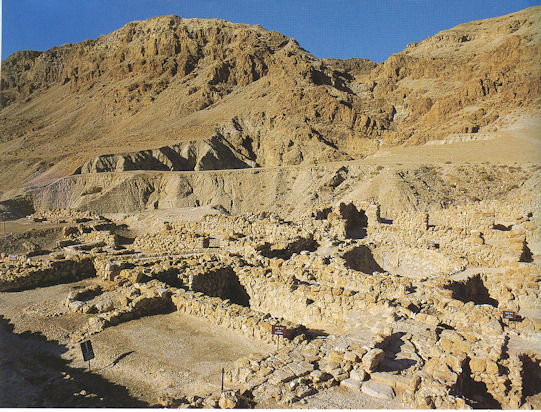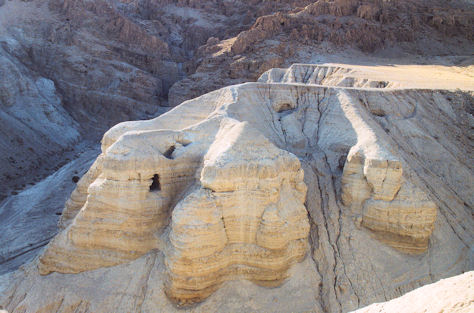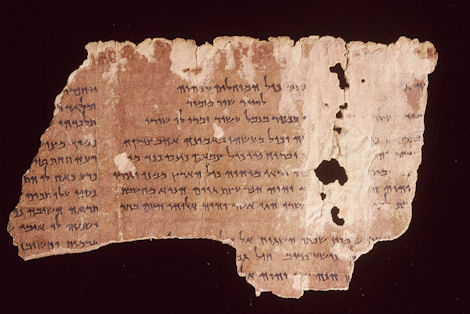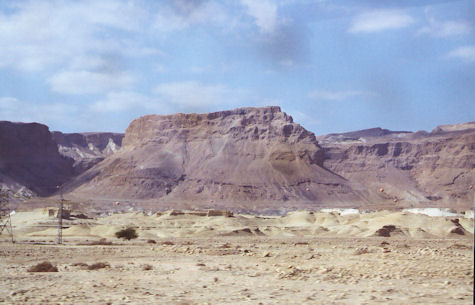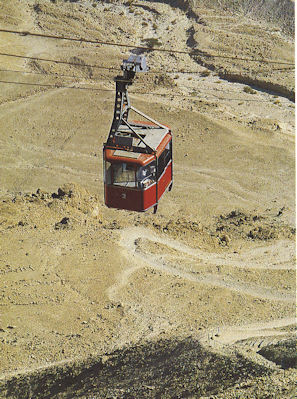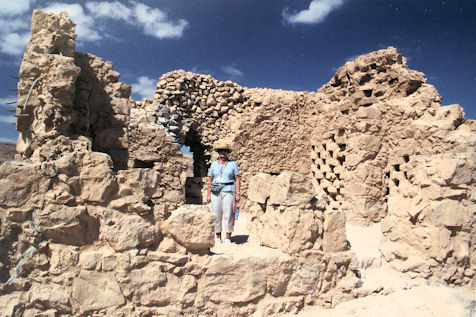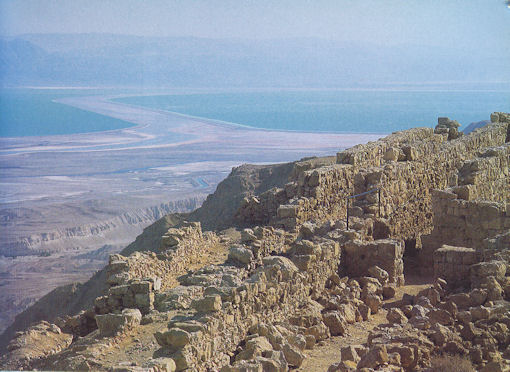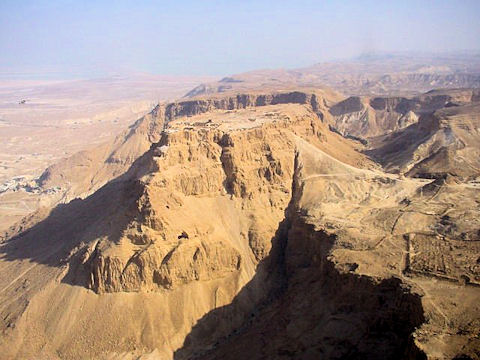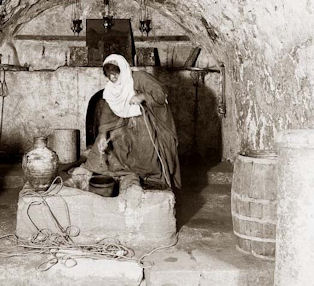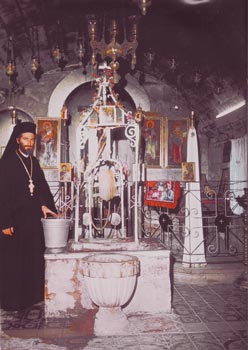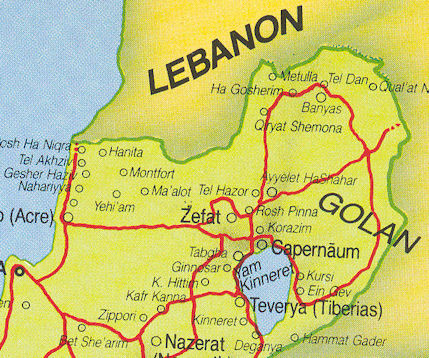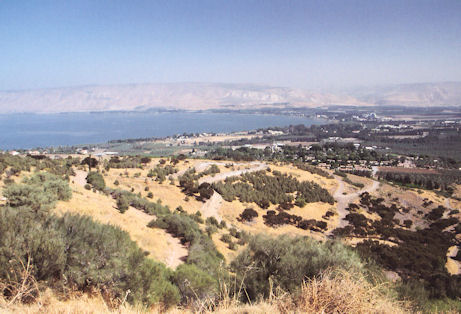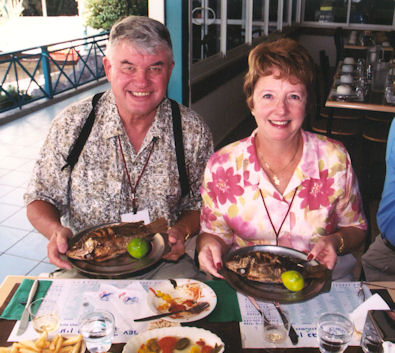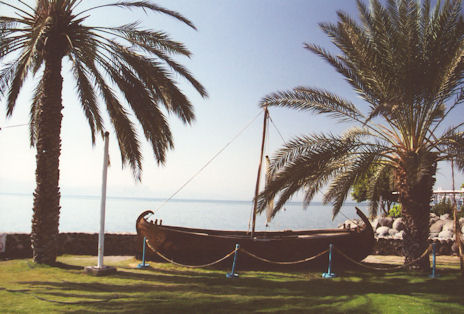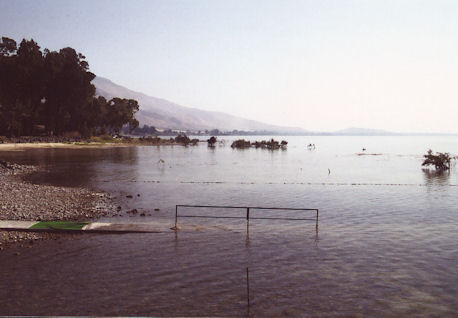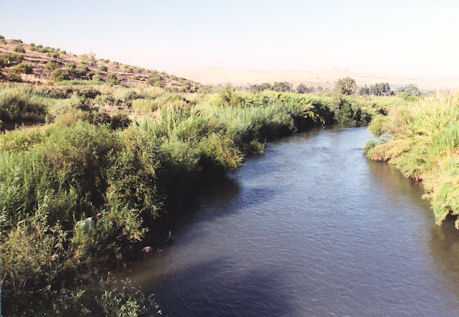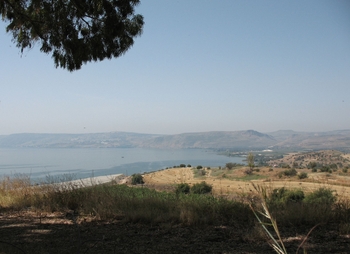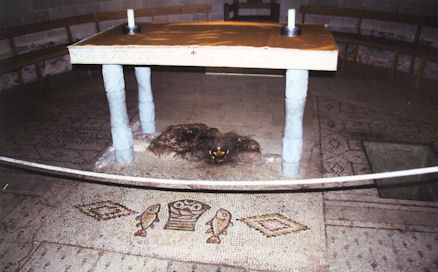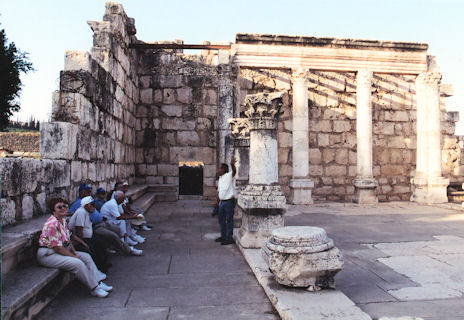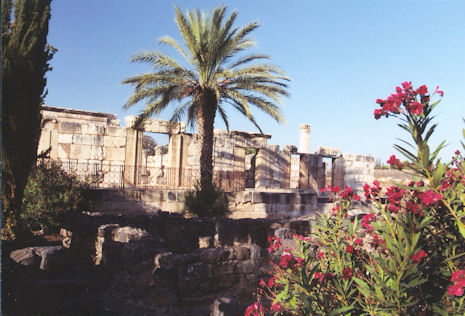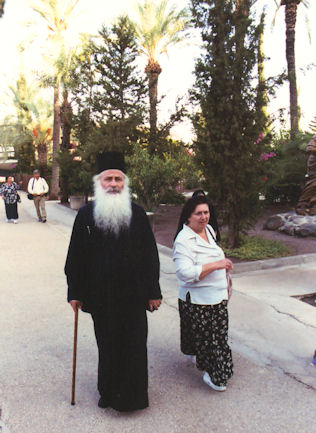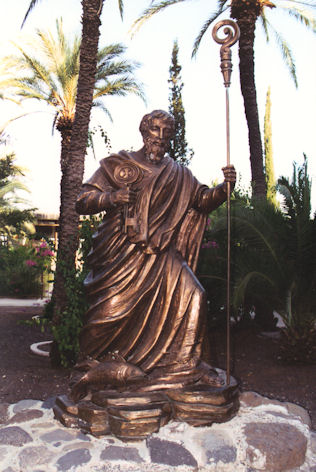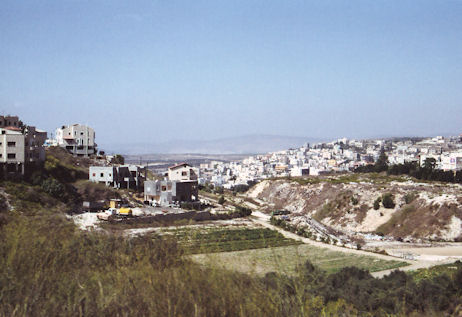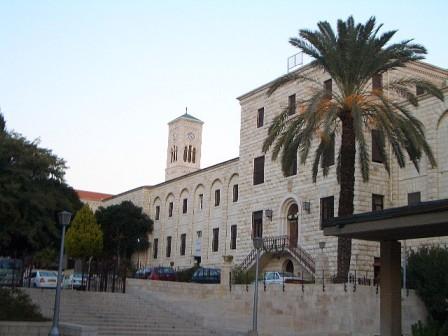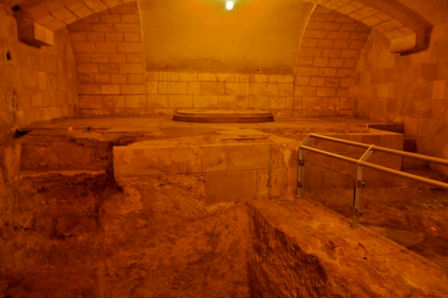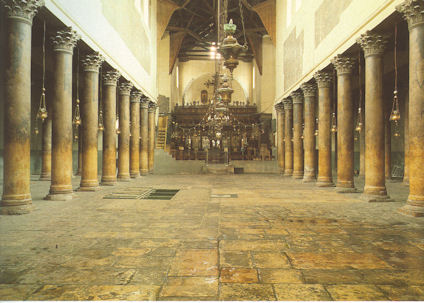
Inside the Basilica of the Nativity.
Joan Jamison nee Sprenger, Fran's cousin,was in Jerusalem at Christmas, about 1970, and she went to Bethlehem on Christmas Eve. That must have been quite an experience.
This location was venerated by the early Christians but the Roman Emperor Hadrian, in 134 A.D. consecrated the woods and caves to Adonis and introduced a pagan cult. In 332, Constantine the Great had the woods cut down and ordered a basilica built on the spot. Much of that basilica was destroyed about 200 years later but it was rebuilt by Justin in the sixth century and later the Crusaders made repairs. The basilica was spared during the Persian invasion of 614 because the invaders found a painting of the three Magi, whom they took to be Persians.
|
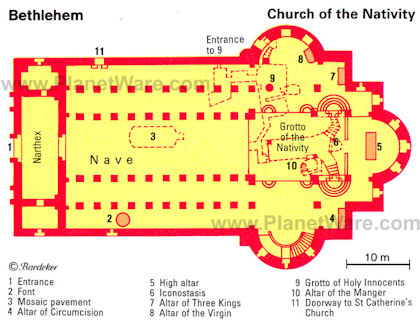
Diagram of the Basilica of the Nativity showing location of Grotto where Jesus was born.
|
The Chapel of the Nativity is located under the main altar of the church.
|
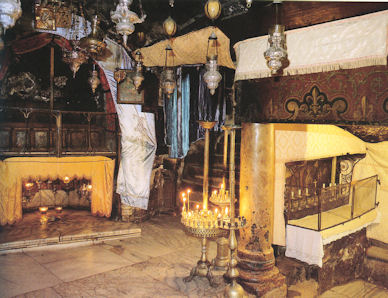
The grotto of the Chapel of the Nativity.
|
In the sunken grotto is the location where the newborn infant was born.
|
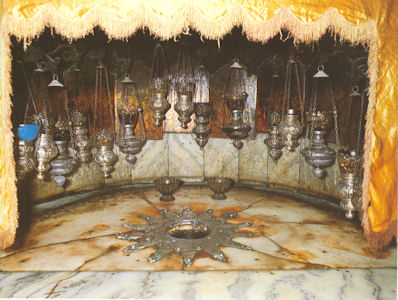
In a small vault a silver star marks the place of Jesus's birth. Above the altar there are fifteen lamps belonging to different Christian communities.
|
One Sunday morning we had a most delightful experience, one which will always live vividly in my memory. We tumbled out of bed very early in the morning and as we hurried out of the city most of Jerusalem was still lost in sleep. We dropped quietly into the valley and then began our climb up the Mount of Olives. It is a steady climb but the ascent is not steep. Little shepherd boys were chattering meaningly to their flocks of goats and sheep in a language that seemed convincing enough and kept them moving on. As we looked back to the East or from where we had come the recently risen sun was lightly dropping a flimsy wrap of soft colors over the city making it appear ethereal and quite incapable of its many sinful ways. We were four on this early morning climb. The fourth member of our party was a girl we had met at the house, a German girl, who had a friend living on the top of the mountain. We soon gained the top and came to a [14] large gate which opened into a young looking garden, then set back in the garden was a tiny home. It looked so friendly that we knew that here was the very place we wanted to rest awhile and have our breakfast. The owner of this inviting little place would not yet be up so we sat in a lovely little garden absorbed in the surrounding country and thinking many thoughts. We read a little from Bibles, had our prayers and sang hymns. It was altogether lovely there in the freshness of the morning and we felt that we were in the presence of One Unseen. Shortly we went in to breakfast we knew very little of this friend who brought us here and certainly nothing of her friend. And so for us there was a pleasant surprise. The door opened, a friendly greeting was called to us and then we saw in the doorway a woman - a big Norwegian and fine looking and wearing a smiling unaffected, happy countenance. We knew her immediately and felt at home. We had our breakfast upon the roof of her little home, and such a meal as we [14b] did eat! Coffee never tasted quite so good as it did that particular morning. Perhaps because it had been made in a pot having a colorful and courageous history. The handle was a little broken and one of us had a minor accident while trying to fill the cup, or was it the refill, I rather think so. So not by way of apology but as an interesting narrative the story of the spot was told. Told by our hostess who spoke very good English with a slightly Norwegian accent. She had gone out of Norway to China as a young missionary sometime before the war. It was during one of the many attacks of internal troubles that China was a victim too, that all missionaries from her territory were ordered out. It was a problem to know what to take or what to leave behind, and they could only take a limited amount for they were being herded into the box cars ordinarily used for animal transportation. So they sorted the necessary from the unnecessary, but our friend could not see herself leaving behind, her nice shiny coffee [15] pot which had recently come from America, Montgomery Ward, and had cost her 49 cents. So she found room to tuck in her precious coffee pot, which proved to be their dearest luxury, if not quite a necessity. It was a long trip. They made several long stops along the way and were housed in queer sorts of places. No proper provision was made for their food, but always they could have coffee - the coffee pot became famous and loved by all. That was twelve years ago and the pot has not lost any of its coffee making super abilities. There we were upon the Mount of Olives, over on the top of Mount Mariah lay the city of Jerusalem and we could see many other familiar places in the distance as we sat there eating together, our breakfast of melon, porridge, bread and honey - one German girl, three American girls, a Norwegian hostess having a Montgomery Ward coffee pot. I hope I can go back there some time.
The view of Jerusalem from the Mount of Olives is stunning. You can see the walled city as it runs along the side of the mountain.
|
The Dome of the Rock dominates the skyline of Jerusalem. You can imagine what it would have looked like if Solomon's Temple were there instead.
|
In the foreground you can see the Jewish cemetery Frances talked about earlier. The deceased were buried in small above ground tombs rather than in caves dug into the side of the mountain. It is common for visitors to the grave to place a small stone on top of the tomb as a remembrance of the deceased's good deeds.
|
This road is called "Palm Sunday Road" because it was used by Jesus to enter the city. It would have been the same one Frances, and we, traversed to get up to the Mount of Olives.
|
We went up the Mount of Olives the second time, went up by car one night, when the moon was full and [15b] away over there was Jerusalem in quite another mood, dressed up in her night lights she looked gay and indifferent and one of us thought aloud and the thought spoken was this: "Oh Jerusalem, Jerusalem, how oft would I have gathered thee into my bosom as a hen gathered her chickens and ye would not."
Dominus Flevit - The Lord Wept - is a small church built on the western slope of the Mount of Olives in 1955 on the ruins of an ancient church. On the floor of the church is a mosaic depicting a hen gather her brood under her wings. It is near here that Jesus wept over his vision of the destruction of Jerusalem.
|
From a window of Dominus Flevit you can see the Dome of the Rock but more importantly the Golden Gate (far right)which used to open into the Temple.
|
We visited several of the hospitals in Jerusalem. There are some really nice institutions located there. The one we particularly enjoyed was the eye hospital. We had become acquainted with the benefactress of the hospital thru a friend. She is unique enough to have stepped out of Dickens. She is a real English lady by right of her lineage. She wears glasses near the distal end of her nose and her clothes look like an assorted lot of Queen Victoria's discards, but she has a heart of gold, a noble character and a strong purpose in life. She is proud of her hospital and she has every right It is well equipped and well kept and [16] takes care of thousands of persons with eye conditions each year. Some people pay but no one receives a bill. As part of the excursion thru she took us into her office to have us register and she told us how several years ago, when the Queen of England was passing thru Palestine she came to call at the hospital and she showed us her signature in the registry and the Queen had signed just "Mary." Such simplicity! There was once another Mary who also had a great simplicity and who was the Mother of Jesus.
We took the road that goes past Gethsemane one day and went down to Jericho, rather we went to the Dead Sea. Jericho is only a short distance from the sea. The first of the trip was pleasant, going thru Bethany where once live Martha, Mary and Lazarus, but soon we entered into a desolate country. If all the rest of loneliness in the whole world could be collected and put together in one small area its degree of loneliness could not compare to the awful [16b] loneliness of these hills. They look like despair, like a wilderness of lost hopes. We did not like them very much, they made us feel uneasy and, anyway, we were physically conscious of the sudden drop in the altitude. By the time we reached the Dead Sea which is 300 feet below sea level, our ears were buzzing noisily on a minor key. It was painfully hot. We really suffered that day. We came into the sea rather unexpectedly. We were going down, down when quite suddenly there was the sea. Trying to swim in the Dead Sea was a funny experience. You ride along on the top of the salty waters and you can't propel yourself decently at all. Because I'm not clever in water stunts I managed to engulp considerable of the lake and it did not make me happy, it feels to be salty enough to be an antiseptic. The hills which circle the sea are ugly by day. The whole scene looks like the distorted [17] plan of an excited mind. However when the fierce heat of the day gave way to a more pleasant mood we began to enjoy being there. The departing sun cast purplish rays and the scene lost its harshness. However, I was glad when it came time to leave and I do not think I will ever want to go back. Night was quickly descending as we drove up to get back again. As we came along we saw camels silhouetted against the skyline as they moved over the hills. They looked so unreal, like they had been out of black paper and pasted there. I'll never get used to camels, they are always such a surprise to me, perhaps partly because I never expected to be seeing any.
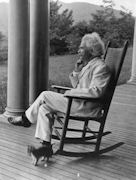 The Camel by Mark Twain: The Camel by Mark Twain:
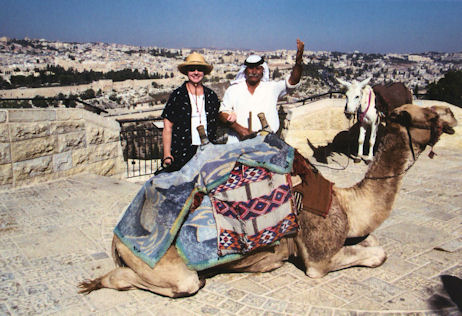
". . . we have been trying for some time to think what a camel looks like, and now we have made it out. When he is down on all his knees, flat on his breast to receive his load, he looks something like a goose swimming; and when he is upright he looks like an ostrich with an extra set of legs. Camels are not beautiful, and their long under lip gives them an exceedingly "gallus" -- [Excuse the slang, no other word will describe it] -- expression. They have immense, flat, forked cushions of feet, that make a track in the dust like a pie with a slice cut out of it.
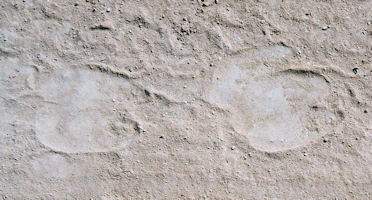
camel footprint in the dust |
They are not particular about their diet. They would eat a tombstone if they could bite it. A thistle grows about here which has needles on it that would piece through leather, I think; if one touches you, you can find relief in nothing but profanity. The camels eat these. They show by their actions that they enjoy them. I suppose it would be a real treat to a camel to have a keg of nails for supper."
|
We traveled to the Dead Sea as well. As you can see from the signs there is but one road and it leads to everywhere. You know we are in the West Bank because the signs are in Hebrew, Arabic and English.
|
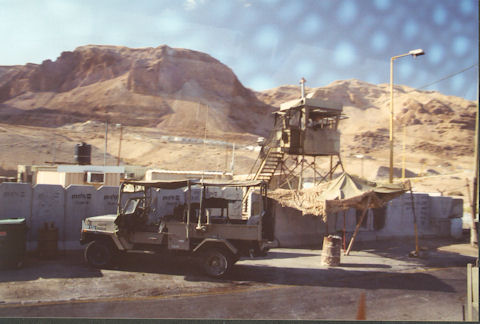
As we left(?) "Israel" we had to go through an armed checkpoint to enter the West Bank. As we drove east toward the Dead Sea Fran asked me, "Is this what is considered the West Bank?" Our Israeli guide, a veteran of the 1969 war, who overheard the question, and to whom it was not directed, coldly and sternly interjected, "There is no West Bank, they will never get this land." So heated are the tensions in this area. We often felt so much hatred of the Palestinians by the Israelis that it filled the air. The hatred did not seem to go both ways, though, the Palestinians did not hate the Israelis, just the government policy of taking their land. One has to think it odd that we can travel at will through the West Bank but the Palestinians cannot get into Israel on the same highway. In fact, I talked to a Palestinian employed by the U.N. on our flight from Amman, Jordan to Cairo, Egypt. He lived in Jerusalem told me that in order for him to go from Amman, Jordan, to Jerusalem, a relatively short distance by land, he has to first fly to Cairo and then fly to Jerusalem. He stated that it isn't the Jews that the Palestinians hate, it is the way the Israeli government is "taking our land."
|
The land between Jerusalem and the Dead Sea is so desolate it is surprising anyone would live there. But it has been the home of the Bedouin Arabs for centuries and not at all unlike what we had seen in the Sahara Desert in Morocco. I have often wondered why people fight over this land. It certainly does not look like a "promised land."
|
The Bedouin, a nomadic people, live in encampments in the desert.
|
An oasis provides water for crops and dates from the trees. You can imagine what a welcome sight this would be for a nomadic people. If you had been traveling for 40 years in the Siani desert this would certainly look like the land of milk and honey.
|
Water has to be trucked in for the sheep. This may be one reason we see so many of he Bedouin camps close to the highway.
|
The Dead Sea is the lowest point on the earth's surface, 1280 feet below sea level. There is no life, except for the swimmers, found in the water and the valley surrounding it is like a blast furnace. Because of the heat and the evaporation of water the lake's salt content is over 30%, ten times normal sea water. Because of the density of the water swimmers find it easy to float. In fact, it is near impossible to walk on the bottom of the lake because your body just floats up and you tip over. So, the best course of action is to accept the conditions, lay down and float.
|
The water also contains other minerals that give it a bitter taste and oily consistency. We were warned not to let it get into their mouth or eyes and fresh water rinsing stations are provided to wash out. There are signs warning swimmers of severe health risks of swallowing the water. There are several chemical plants along the coast that mine some of the minerals in the water. The Dead Sea is famous for its therapeutic properties and is effective in the treatment of skin disorders. Covering yourself with the mud from the bottom of the sea is a popular activity.
|
Hidden under a mud mask the girls swarmed to this mysterious stranger.
|
The object is to cover yourself with mud and than bask in the sun.
|
Modern Day Extra
Two places by the Dead Sea that Frances did not visit.
Qumran - The Dead Sea Scrolls
Although ruins of the settlement are right on the highway to the Dead Sea,
where Frances was headed to go swimming, there would have been no reason
to stop because its historical significance had not yet been discovered
Ruins of the monastic settlement inhabited by an ancient Hebrew sect, the Essenes, who lived here between the second century B.C. and 68 A.D. The doctrines and rites were surprisingly similar to those of the early Christians. They sought to live a life of purity far from the pomp and magnificence of Jerusalem. They took refuge in the desert, where they lived in poverty and divided the fruits of their labors equally among themselves. They performed purifying rites such as baptism and studied the scriptures as they awaited the end of the world. There is some speculation that John the Baptist lived in this, or a similar, community. In 68 A.D. Vespasian's Tenth Legion occupied the area and scattered the members of the sect.
|
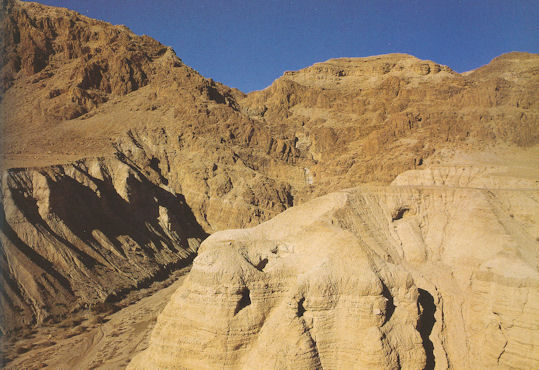
Cave of the dead sea scrolls.
After the Jewish revolt of 66 A.D. (now called CE for Common Era in order to take the religious connection out of the dating system) was crushed in Jerusalem the Roman army moved toward the Dead Sea. Members of the Qumran community scattered into the desert. In order to preserve their religious teachings the scrolls, written on lamb skins, were sealed in large clay jars and hidden in the caves surrounding the area. Obviously they were intended to be retrieved when the community could be reformed at a later date. The reconstruction never took place and the scrolls forgotten.
|
In 1947 the scrolls were found by chance when a shepherd boy saw an opening in the ground and he threw in a rock. The rock landed on one of the clay pots and when the boy heard an unusual "ting" he climbed down to investigate and found numerous pots with the scrolls wrapped in linen and placed in carefully sealed jars, an indication that whoever hid them did all in his power to preserve them. Exploration of surrounding caves found hundreds of manuscripts, not all of which had been so carefully preserved. |
The manuscripts, mostly written in Hebrew and some in Aramaic, date back about a thousand years earlier than the oldest examples of Hebrew Scriptures known up to that time. They contain all of the Old Testament texts except Esther, and include the Apocrypha and the rules and doctrines of the Qumran community. Having no idea what he had found the shepherd boy sold the scrolls for pennies and eventually they were offered for sale in the want ads of a Jerusalem newspaper. Not all of the scrolls have been translated and the process is very slow because much of them fall apart into small pieces as they are unrolled. To say the least the scrolls are treasured by both the Jewish and Christian communities.
|
Masada - A Mountain Fortress
Frances could have driven right by the mountain fortress of Masada in 1935 but it would not have had any significance to anyone at that time. Today, after the formation of Israel as an independent nation in 1948, it is a symbol national strength. The name today stand out as a warning and a promise is the phrase "Masada shall not fall again" recited by elite Israeli fighting units after they climb the cliffs and take their oath of allegiance on the site.
Herod had first built a fortress at the top of the mountain to protect him in case of a revolution. Following the destruction of the Temple in Jerusalem in 70 A.D. a group of Jewish rebels took over the fortress and for three years fought off a Roman siege.
|
Today you get to the top of the fortress via a cable car. If Frances had an undying urge to visit it in 1935 she would have had to follow the winding goat path or climb to the top.
|
The ruins of Herod's fortress and the rebel community are still visible.
|
The view from Masada toward the Dead Sea is spectacular. When the Roman army attacked the rebels the assault was impossible. Steep sides of the cliff made it an easy location to defend. For three years the rebels repelled the Roman attack.
|
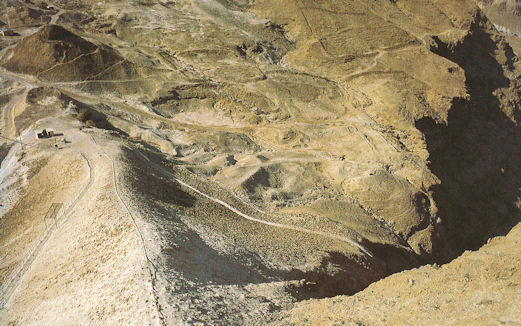
The Roman commander, Flavious Silva, had an enormous access ramp constructed on the side of the mountain allowing the army easy access. For years - imagine how long it would take to built this ramp by hand, over 100,000 men were put to the task - the rebels watched the Romans build the ramp on the west side. On the eve of the final Roman attack 960 members of the Jewish rebels committed suicide rather than being taken captive and into slavery by the Romans. To the Romans it was a hollow victory and for the modern Jewish state, founded in the aftermath of the holocaust of WWII, a symbol that never again will the Hebrews be subjected to foreign rule.
While on top of the mountain our guide made some other comments that betrayed his dislike of the Arabs. At one point he told us that he knew many of us would be going to Egypt and then to Jordan and we would find ourselves on the other side of the Dead Sea looking across to Israel. He made it clear that we would be told many lies about Israeli history and we should not pay attention to them. The Indians used to call this, "Poisoning the well". Drink the fresh cool water of discovery but then poison the well so the Arab sites and culture will not have the same level of excitement. His comments were very distasteful and even the waters of Canaan lost some of its sweetness. Someone told us we should have had an Arab Christian guide and our experience would have been a lot different. Little did we know!
|
The immense size of the earthen ramp built by the Romans can be seen in this photo. All the dirt had to be carried into position in baskets. As we sat on the top of Masada our guide, a veteran of the six day war of 1967, told us how he and his wife, along with other family members, were taken to the top of the fortress as their son, having just graduated from the elite army training, climbed the cliffs of the mountain. The soldiers were given the option of using the Roman ramp and they all refused, choosing instead to climb the steep walls. Our guide had tears in his eyes as he told us about the pride he felt when he saw his son climb over the stone walls at the top of mountain. He told us, "Masada shall not fall again." Such is his zeal for Israel.
|
The last week of our stay in Palestine we gave up our room, packed our bags, and took to the trails. We made satisfactory arrangements with a tourist service for our transportation. So, early one morning we set off, planning to arrive at the Sea of Galilee sometime in the afternoon. It is about a [17b] hundred mile drive. We first came to a little village of El Bireh. This is said to be the village where Mary and Joseph first missed Jesus on their return journey to Nazareth. There is some evidence of an old town. This little village is twelve miles from Jerusalem and was the usual stopping off place because the distance was one days trip. Strange that Christ's parents should travel full day without realizing his absence from the group. But at that time Christ was a boy with boyish characteristics and so they probably expected to find him in company with the other boys.
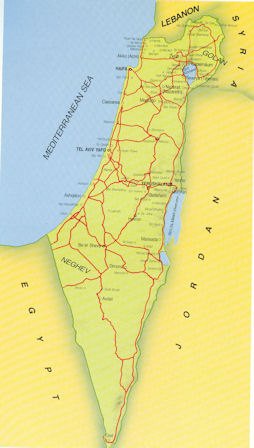
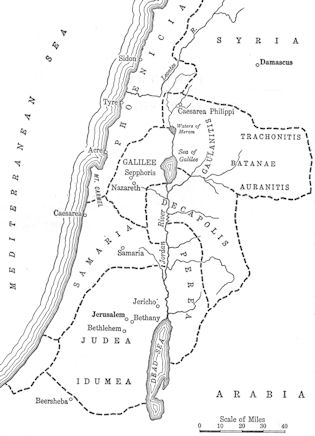
After awhile we entered into the country of Samaria. So far the country side seemed very much the same temper. We thought for all its being the land of promise most of it looked barren and unproductive. However, it hides its lamp under a bushel, and grows a good many bushels full of food stuffs. The land of Samaria [18] was much the same temper. We soon arrived at Jacob's well and we stopped for water. It's true we did have a drink from Jacob's well. Someone has tried to build a church over that well and then left it in an unfinished state. This well must be full to its depth with secrets and it must often yearn for the freedom it had for so many, many years, for the women used it daily to gather and draw water; fill their heavy pitchers, while they exchanged gossip, discussed their problems, and shared their joys. And one day a certain one of them came to draw water at an irregular hour, came to avoid ridicule likely, for she had well earned the scorn of other women, and the one who had arrived before her spoke and later the woman answered; "Sir, give me this water, that I thirst not, neither come hither to draw." Yes, I feel sorry about this well being tucked away in the basement of a church. I'd like to set it free and let it be useful again. I'm sure its not enjoying its decorated uselessness. The water was good, we each had [18b] two drinks.
We did not visit Jacob's well and photographs are hard to find but this will give you an idea of what it looked like.
|
The Greek Orthodox church seems to have turned everything into a shrine.
|
We arrived at the Sea of Galilee in the afternoon. We were tired and worn when we arrived so we did not allow ourselves to indulge in first impressions. Again the altitude is below sea-level. We stayed at Father Tapper's, everyone that goes to the Galilean Sea stays at Father Tappers, at least everyone should stay there. It's a homely dear place kept by German monks and sisters. We were shown to our rooms by a sweet-faced German nun, and after a little nap we donned our swimming suits to go out for a swim. It was then about five o'clock, the sun had nearly spent himself and the warmth of his controlled emotions was quite welcome. Yes, I remember us looking a little bluish when we came out of the water because old "Sol" got tired and went home from playing before we did. We had such a lovely time in that lake. The water was quiet as a mirror and it cleaned and cooled our bodies and lightened our [19] spirits. Does it not sound sacrilegious to say that we shampooed our hair in the Sea of Galilee? And when we dressed for dinner that night we were filled with a new personal pride and a great joy of living because we felt that we were just the cleanest persons on earth. I'll never forget that refreshing dip in the lake. Really, it was the cleanest clean feeling I have ever experienced, and we found the burden of a bountiful German dinner deliciously acceptable, and so we broke bread with these German monks and were served by sweet-faced German sisters. Their little snatches of German were like music to my ears. I have wished a thousand times that I had grown up knowing German. After our dinner we went out in a boat. The night was perfect, the moon had not risen yet but many of the stars were a path of light on the tranquil waters. I remember the brilliance of Venus in particular. We sang hymns to the rhythm of the softly dipping oars. Peace reigned supreme, but they told [19b] us that fierce storms came almost instantaneously. As we neared the shore to embark a moon was just rising over the horizon, looking a little shame-faced and apologetic for his tardiness.
Mark Twain also went swimming in the Sea of Galilee.
|
"At noon we took a swim in the Sea of Galilee -- a blessed privilege in this roasting climate -- and then lunched under a neglected old fig-tree at the fountain they call Ain-et-Tin, a hundred yards from ruined Capernaum. Every rivulet that gurgles out of the rocks and sands of this part of the world is dubbed with the title of "fountain," and people familiar with the Hudson, the great lakes and the Mississippi fall into transports o admiration over them, and exhaust their powers of composition in writing their praises. If all the poetry and nonsense that have been discharged upon the fountains and the bland scenery of tis reason were collected in a book, it would make a most valuable volume to burn."
"The celebrated Sea of Galilee is not so large a sea as Lake Tahoe -- [I measure all lakes by Tahoe, partly because I am far more familiar with it than with any other, and partly because I have such a a high admiration for it and such a world of pleasant recollections of it, that it is very nearly impossible for me to speak of lakes and not mention it.] -- by a good deal -- it is just about two-thirds as large. And when we come to speak of beauty, this sea is no more to be compared to Tahoe than a meridian of longitude is to a rainbow. The dim waters of this pool can not suggest the limpid brilliance of Tahoe; these low, shaven, yellow hillocks of rocks and sand, so devoid of perspective, can not suggest the grand peaks that compass Tahoe like a wall, and whose ribbed and chasmed fronts are clad with stately pines that seem to grow small and smaller as they climb, till one might fancy them reduced to weeds and shrubs far upward, where they join the everlasting snows. Silence and solitude brood over Tahoe; and silence and solitude brood also over this lake of Genessaret. But the solitude of the one is as cheerful and fascinating as the solitude of the other is dismal and repellant."
|
Although the Sea of Galilee is below sea level the Jordan River flows south to the Dead Sea which has no outlet. Thus the Sea of Galilee is a fresh water lake and has always been a source of fishing.
|
We stopped at a Kabutz on the eastern shore of the Sea below the Golan Heights. On the menu was "St. Peter's fish." It was the same fish that Peter and the disciples would have caught before they became "fishers of men."
|
After lunch we were able to walk around the site and examine this model of the kinds of boats used by fishermen on the Sea of Galilee during Peter's time.
|
You can see how calm the sea can be in October. A cement walk, with appropriate hand rail, was installed so guests could test out their skills of walking on water, or at least wade safely into the Sea of Galilee.
|
When we left the Kabutz we continued counter-clockwise around the Sea of Galilee - and thus crossed the Jordan River on the north end of the lake. The traditional location of Jesus' baptism by John the Baptist is on the south end of the lake and in Jordan so we couldn't (or at least our Jewish guide couldn't) cross the border.
|
|
The next morning early, found us out by the sea, as of old the fishermen work in the first streaks of light. Look! There it is! That could be the boat. Those men are looking discouraged and tired for they have been fishing for hours without success. And over on that other shore surely there is a figure dimly outlined against a sky that is warning fishermen to hurry lest the day break before they are ready. The Figure speaks and what he first says is commonplace enough, but, its his voice - is it not familiar? They follow his instructions and their success is overwhelming and not a single net is torn. But see! They recognize him and the impetuous Peter is already in the water swimming to shore. The fire is already laid. See [20] them sitting down near the pleasant warmth of the fire, in the stillness and dreariness of an early morning, enjoying the companionship of a meal together. See, they are eating with a zest which comes from many hours of hard labor. I, eating almost in silence, surely not because they are too busy appeasing their physical appetites but only because the moment is so full. Their faces are filled with wonder and awe and a great happiness because their friend has come back to them again. There is such joy in the face of the Master. Those eyes which had been so sad just a few days ago, are lighted, and he looks at them with love and understanding and a look that is softly compelling. We hear a voice coming to us across the still water, a voice that is soft and clear and sweet, saying "Feed my sheep" and then we quite suddenly realize that the gentle command we hear is the echo of that same command given so many years ago [20b] coming to us after twenty centuries of time.
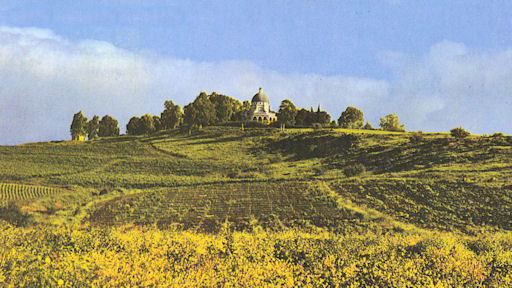
Mount of the Beatitudes - Tabgha
Now we have to use our imagination - its obvious that Frances did when she is describing what the disciples must have thought as they saw their friend walking on the beach. I can't find any reference to Father Tapper's and I'm not surprised after all these years. But taking into account Frances' description of where she was and what she saw I am going to put her at Tabgha which is located only two miles west of Capernium. In her next paragraph she talks about walking from Father Tappers to Capernium and that would be a logical and an easily distance for a day's walk - especially for a farm girl. Tabgha was built in 1938 and is maintained by Franciscan nuns so it would not have been present when Frances visited the Holy Land in 1935 but was when we were there in 2003.
|
The church sits on a hill overlooking the Sea of Galilee.
|
Josephus referred to as the "well of Capernium." Undoubtedly a popular fishing spot of the locals because of its famous "seven springs," Heptapegon (today the name has been corrupted to Tabgha) is the traditional location for several episodes in Jesus' ministry. The seven springs that emerged at Tabgha (today only six have been discovered) produced water warmer than that of the Sea of Galilee. This warmer water helped the production of algae, which in turn attracted the fish. Fishermen thus have frequented this area for thousands of years.
|
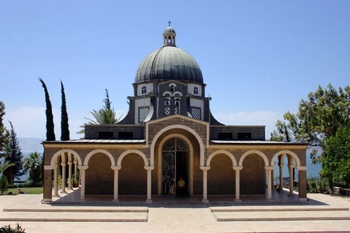
Located on a small hill overlooking the Sea of Galilee near Tabgha, the Mount of Beatitudes is the traditional site of Jesus' delivery of the Sermon on the Mount, probably the most famous sermon of all time. Ruins of a small church dated to the late 4th century have been discovered downhill from the present church. It has a rock-cut cistern beneath it and the remains of a little monastery to its south and southeast.
Pilgrims are known to have commemorated the Sermon on the Mount near here since the 4th century. After describing the Church of the Loaves and Fishes, the Spanish pilgrim Egeria (c.381) wrote, "Near there on a mountain is the cave to which the Savior climbed and spoke the Beatitudes."
Regardless of whether this is the very spot, the Church of the Beatitudes stands in the right general area and in a very similar setting to where Jesus would have stood as he delivered his famous sermon. As Murphy-O'Connor puts it, from here "one can see virtually all the places in which Jesus lived and worked".
|
This Byzantine mosaic is preserved under a modern church today, but it was once part of a church which commemorated Jesus' feeding of the 5000. |
|
Tabgha is the traditional location for the calling of the disciples. It is believed that here Jesus walked along the shore and called out to Simon Peter and Andrew who were casting their nets into the lake. Walking along, Jesus saw two other brothers, James and John who were preparing their nets with their father Zebedee. Jesus called all of these men to follow him. It was perhaps inevitable that this well-watered area with its shade trees on the shore of the Sea of Galilee, where Byzantine pilgrims ate their picnics, should have been identified as the location of two episodes involving the consumption of food, the multiplication of the loaves and fishes and the conferral on Peter of the responsibility of leadership after a fish breakfast. Then it became convenient to localize the Sermon of the Mount on the small hill nearby.
|
Evidence of ancient boating activity at Tabgha is found in the recently discovered harbor on the shore. Visible when the water level is -211.50 m or lower, the curved western breakwater was 60 meters long. Another 40 m breakwater ran perpendicular to the shore and protected the 30 m wide basin which was entered from the east.
|
After our breakfast we went to some of the interesting places along the shore-line. Among them the ruins of old Caperneum. About two years ago someone set out to rebuild from the ruins the old Jewish synagogue but he met with an automobile accident and was instantly killed. But enough of the old columns and blocks of stone heave been placed in position to give a general idea of the plan of the building. The style of architecture is Roman and must have been very beautiful at one time.
The synagogue at Capernium
|
|
Greek Orthodox priest walking the street in Capernium
|
Peter lived in Capernium and thus Jesus spent a lot of time there. In fact, I understand he lived with Peter for a while. Peter's home is just across the street from the synagogue and was under excavation when we were there. Everything was covered so I couldn't get a good photograph.
|
"Then Jesus said unto them: Verily, verily I say unto you, Except ye eat the flesh of the Son of Man and drink his blood ye have no life in you." These things said he in the synagogue, as he taught in Capernium.
We came home to Father Tapper's in the afternoon. We left with reluctant [21] steps and only because time was limited and we had to get on. So we, hurried along to reach Mount Carmel at sunset. We soon came to Nazareth. It is a pretty town, so white looking and set in the hills. Here would be the carpenter shop of Joseph. We were warned to wear long sleeves, so we began hunting out jackets and coats, and I found mine to be missing. I had forgotten to bring it along and it was still hanging in the wardrobe of my room at Father Tapper's. All our heavy luggage was strapped on the back of the car. There was only one possibility in my small bag and that was my kimono, so dressed in a straw hat and a dressing gown we visited the churches in Nazareth. It rather spoiled the solemnity of church going for I did look very funny. Under one of the churches is a large grotto. This home in the rock is considered to be the home of Joseph and Mary and where Christ grew to man's stature. [21b] The carpenter shop was part of the home. This spot seems to be more authentic than many of them, at least if his is not the same house hewn out the side of a rock, Christ lived in one very similar.
There was one old Jewish synagogue at Nazareth that looked as though it had stepped out of the old Testament. This was the only synagogue we visited.
The small town of Nazareth has grown since the time of Jesus.
|
The church of Saint Joseph which contains the ruins of the boyhood home of Jesus and Joseph's carpentry workshop in the basement.
|
It was not uncommon for families to live above the workshop and thus the assumption that Jesus' home must be in the same location.
|
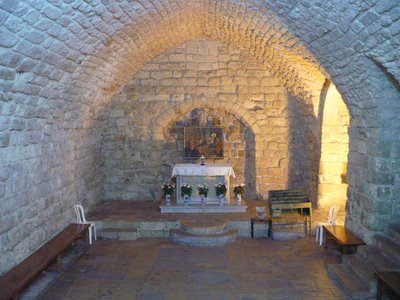
The Synagogue Church
After Jesus had grown to manhood he returned to Nazareth and spoke in the synagogue. It didn't turn out to be exactly a prophets welcome. The report goes as follows:
He turned, handed the scroll back to the Gabai, the attendant, and said, Today this scripture is fulfilled in your hearing. A hush came over the congregation. For a moment they seemed stunned. Then someone asked, “How can this be? Isn't this Joseph's son? Wasn't it Joshua, the boy they had known growing up? Hadn't they watched him play with their own sons and daughters? Many had entertained him and his family for holiday meals in their own homes.
There were those among them who remembered when Jesus as a boy had eloquently led the synagogue services reciting the Sabbath readings with similar earnestness and sincerity. But now he was a full grown man and he spoke with such authority. Suddenly members of the synagogue began to taunt him. Why don't you do some of those healings we heard about, over in Capernium?
Then Jesus responded: Truly I tell you, no prophet is accepted in his own hometown. He then spoke of how Elijah was sent to a widow in the region of Sidon and how Elisha was only able to heal Naaman the Syrian.
The crowd of worshipers begin to gather around Jesus, dragging him from his seat and pushing him toward the door.
Stand aside as they violently force the Master out to the ledge of a cliff, ready to push him off. The Bible tells us
(Luke 4:28-30): All the people in the synagogue were furious when they heard this. They got up, drove him out of the town, and took him to the brow of the hill on which the town was built, in order to throw him off the cliff. But he walked right through the crowd and went on his way.
|
The streets of Nazareth are narrow and winding and cleaner than many of the other villages. Leaving Nazareth we drove West.
The country shortly before we reached our destination was lovely and green and the fields were well cultivated. We saw several modern machines at work in the fields, not much like the old threshing floors and the simple plows which are still in use in Judea. This land is owned by the New Zionist colony that you have undoubtedly read about. It has a look of home [22] about it.
We went up and up and up and up and finally we came to the upmost part of Mount Carmel. There was a glorious sunset and we harbored the secret thoughts of its being so glorious especially for us. The next morning we tramped down the mountainside. It is wooded and grassy and covered with brush and trees by turns. There were rocks and pines and weeds and flowers. We came back covered with stick tights. It gave me a more "nearest to home" feeling I've had since I left America!
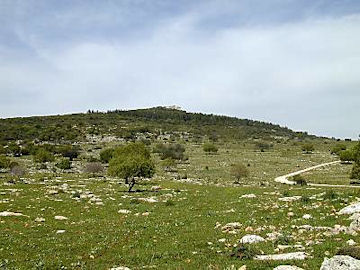 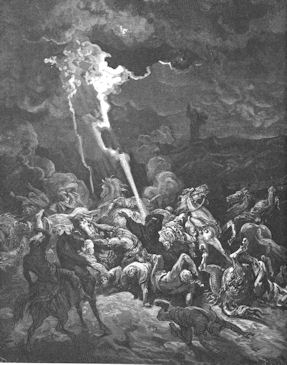
I wondered why Frances visited Mount Carmel. Perhaps this short history will remind you of its significance in the Old Testament.
Over the centuries, ever since the Hebrews invaded Canaan the Israelites had to compete with the worship of pagan gods. One of those was Baal whose worship was sometimes banned, at other times tolerated, and sometimes it was even accepted as part of the Jewish ritual. Naturally, at some point things had to come to a head.
After the death of Solomon in 922 B.C. the kingdom was divided; Judah to the south and Israel to the north. The king of Israel constructed a new capital city and the region became known as Samaria and the inhabitants Samaritans. The Samaritans were in constant conflict with the Syrians to the north and Ahab, son of the king of Samaria, married Jezebel, daughter of the Phoenician king, to forge an alliance against the Syrians. The marriage eventually brought ruin to the Israelite monarchy. Jezebel introduced the Phoenician pagan god Baal with the approval and support of Ahab. Yahweh did not look kindly upon this "evil" when Ahab set up an altar for Baal in the temple of Baal he had built in Samaria. Some called it a "pragmatic policy of religious tolerance."
Offended at the worship of Baal by the Samaritans, Yahweh punished the kingdom with a severe drought. After three years of drought Yahweh told the prophet Elijah to go to Ahab and "I will send rain." Elijah went to Ahab and accused him of ruining Israel by deserting Yahweh. He proposed a contest between himself and "the four hundred prophets of Baal who ate at Jezebel's table."
The contest was held on Mount Carmel, in the presence of the assembled Israelites, to see if Yahweh or Baal was the greater god. The challenge was to see which god would bring down fire to the altars set up by the prophets of Baal and then Elijah. The prophets of Baal went first and danced and besought Baal to hear them but to no avail. Then Elijah built his altar, and to prove the strength of Yahweh soaked it with water. when Elijah called upon Yahweh fire fell and consumed the offering and the wood and licked up the water. At Elijah's command the people seized the prophets of Baal and Elijah slaughtered them. Jezebel met a terrible death years later when she was thrown from a window and the dogs devoured her body thus fulfilling Elijah's prophecy, "The dogs will eat Jezebel in the field of Jezreel."
|
|
This visit at Mt. Carmel brought to a close our sojourning in the land of Palestine. We came home by boat. I couldn't possibly sum up for you all I feel about Palestine or how much it meant to me to have had this experience, and I think I've enjoyed it even more since I've been back. Often as I read I find my finger tracing out a tiny imaginary path across the page [22b] of my Bible.
Some things were disappointing. Yes, very. But to look out over the hills of Moab, to see the sun rise from the Mount of Olives and to sit beside the gurgling Galilean Sea as it happily laps up the shores. These things are unchanging. I've tried to give you a little bit of my feeling for Palestine, to share with you the joy that was ours.
With these things I will leave you.
Love always,
Frances Sprenger
1935

For more information just write to

Bob Frazee
Web Master

Since August 30, 2011, you are visitor number
